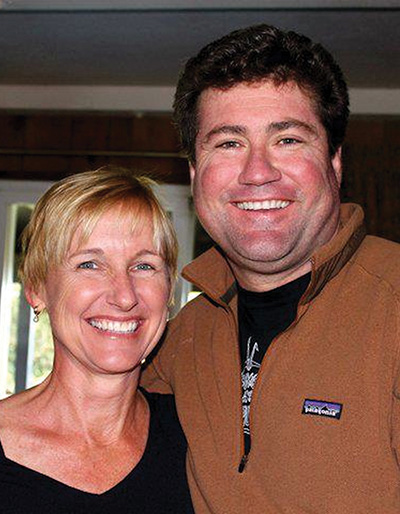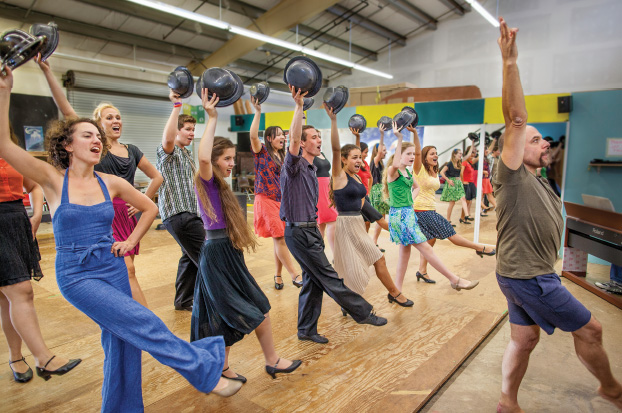
The Voice of Skylark: Radio Diva and Passionate Advocate for Hawaiian Music

By Karen Valentine
A voice that could melt butter—velvety smooth and honed over a few decades of broadcasting and emcee gigs—is that of Skylark, professional name of the radio diva born as Jacqueline Leilani Rossetti. It’s not put-on or pretentious; it’s her everyday voice, and it issues from deep within the woman who has helped shape the public awareness of Hawaiian music, from its famous renaissance period during the ‘70s up until today. Her sincere love of the music and her passion for telling the stories of its musicians resonates in her voice.
First known as the Honolulu Skylark, the renowned radio personality is a Hilo resident today and famous statewide in the music world. She was recognized as Outstanding Hawaiian Woman of the Year in 1984, Broadcaster of the Year in 1991, and won two Nā Hōkū Hanohano Awards, first in 1993 and then in 1996. In 2011, she was honored with the Lifetime Achievement Award from the Hawai‘i Academy of Recording Arts. She is cofounder of the Nā Hōkū Hanohano Awards, Hawai‘i’s version of the Grammy Awards, and has announced, broadcasted, and emceed the Merrie Monarch competition and hō‘ike presentations for more than 30 years.
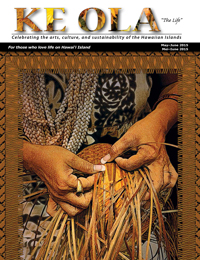
To learn what led up to these accolades, we first flash back to 1975. The O‘ahu native and Kamehameha Schools graduate was returning to Honolulu after attending college and working for several years in San Francisco, California.
“I thought I was going to be a world famous graphic designer,” Skylark says, smiling. “But during college, I fell into radio broadcasting and graduated with a third-class FCC license. I said, ‘Okay, let’s take on the world in radio.’ Also, my real passion was and is always Hawaiian music, so I ended up doing a Hawaiian music radio show in San Francisco at a small station called KPOO.”
With her strong heritage in Hawaiian ways, it was no wonder she soon got homesick and found her way back.
“I grew up in a big Hawaiian family from my mother’s side, and we would gather at a family home in Ka‘a‘awa. We were always sitting around and playing Hawaiian music at family gatherings. We fished, did hukilau, pulled taro, and had our own imu.”
Though Skylark’s father was pure Italian, meeting her mom at Pearl Harbor, she says he “became more Hawaiian, almost, than my mother. Dad was involved with the festival called Aloha Week back then, and he surrounded us with just wonderful mentors that were our aunties. He was hānai’d by Aunty ‘Iolani Luahine, for example.”
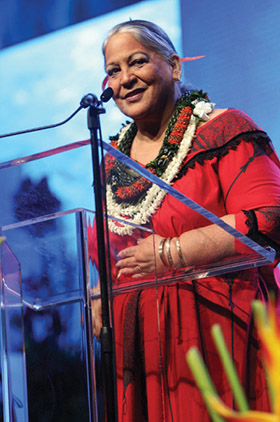
City life on the mainland just didn’t fit Skylark. Back home in Honolulu, she tried for jobs at all the radio stations.
“I realized that Hawaiian music was not being played, not even in Hawai‘i! They were doing the funky hula. But it wasn’t the stuff I grew up with. I felt there was a need to do something,” she says with all the idealism of a young college grad.
“So I went to the only Hawaiian music station in Honolulu, KCCN, and they wouldn’t hire me. So I said, ‘Something’s wrong here.’ I got hired at all these other radio stations, like a Filipino station and a Japanese station, because I was an American citizen with a license. Then this gentleman who had an all-women’s radio station called me up and said, ‘Why don’t you come work for me?’ It was called KNDI, ‘Kandy.’”
She went to work with them and discovered Hawaiian music was played at midnight.
“I said, ‘I want that shift,’ and he said, ‘No, I want you to train to learn all about radio.’
Women ran the entire station, which was unprecedented in the 1970s. Skylark was permitted to run the station from 4pm until midnight, after which point she would get a police escort to her car.
“Still, I kept saying, ‘I want that shift.’”
Skylark’s approach to the midnight shift was a departure from the common “closed board” practice of spinning records and not talking. She even went beyond the usual DJ patter mixed with music. Carrying a microphone and tape recorder, she hit the streets of Waikīkī when all of the lounge acts were finishing up.
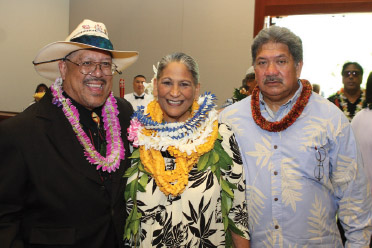
She would play her recordings of Uncle Sonny Chillingworth, or ‘Olomana, or Hui Ohana on the radio.
“It was just fabulous! I just loved those days!”
KCCN heard about her and convinced her to go there, even though it was less money. She obliged because it was the Hawaiian music station. Skylark continued interviewing the musicians and songwriters, and her original recordings soon grew into longer, three-hour sessions that would later be accepted into the Library of Congress in Washington, DC.
“I did a program on KCCN called the Heritage Series, highlighting artists, musicians, and their stories. It aired for five years straight once a month on a Sunday. I wanted so much to learn all about the authors of songs and why they wrote them. It was right at the crucial time, where there was that transition between musicians of the 40s, 50s, and 60s leaving us and the new generation of the 70s. I went in-depth with the artists, some of them playing live on the air. One of my favorites was John Kameaaloha Almeida.”
Almeida was a blind musician known as the “Dean of Hawaiian Music.” His life spanned the eras from the Hawaiian Monarchy through statehood, up until 1985 when he died at age 87. Almeida had played at Queen Lili‘uokalani’s funeral in 1914, was chief musician on the Matson Lines ships during the ‘20s, and he composed more than 300 songs, including “Green Rose Hula” and “Iesu Me Ke Kanaka Waiwai.”

Other iconic musicians interviewed by Skylark in the series include Alvin Isaacs, Andy Cummings, and Gabby Pahinui.
She even went to Kaho‘olawe when protests against military occupation and bombing were occurring to record some of the kūpuna that were born and raised there.
“I think it’s important that we document these things and that we learn,” she explains. “I have this passion because I’m curious.”
Skylark chooses to focus on the music and musicians, with no desire to be the star herself.
“The radio stations at the time were just playing music and spinning discs. The DJ was the talent. I didn’t want to be the talent, I wanted to share the stories and have the talent focused on them. I wanted to honor them. And from that honoring came the Nā Hōkū Hanohano Awards, which we designed to honor our local musicians, simply because [at that time] they would never win a Grammy, so someone needed to start recognizing them.”
Skylark, DJ Krash Kealoha, and the rest of the staff at KCCN put on the very first Nā Hōkū Hanohano Awards in 1978. It grew each year; then the Hawai‘i Academy of Recording Arts (HARA) took over administration of the awards in 1982.
Live Honolulu radio, including Skylark’s show, also helped make the stars. One of them was Israel Kamakawiwo‘ole, also known as Bruddah Iz.
“He must have been 13 or 14 years old when I first met him. He and his brother, Skippy, would call me up on the midnight show at KNDI.
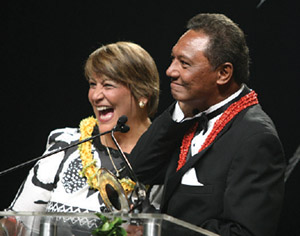
Skylark says Bruddah Iz loved radio. “It kept him entertained. He said, ‘Come on out to Makaha. I have this group; I want you to hear us.’” So Skylark did, “and there they were—just these kids in puka (holey) clothes—but their harmonies, their voices, and their family unit was so endearing—I just loved them.”
Skylark continues, “I brought them to KCCN after I moved there, and we did their first recording—this was when we could play bootleg music on the air. And so that’s how they started their career.”
By 1991, Skylark had three children and was ready for a change. She moved to Hilo, her motherʻs home town.
“It was in a rural area where we could have dogs and cats and not live in an apartment where the kids would have to take an elevator home. I could go down the street, wave to my neighbor, and he would wave back to me. That’s how I still look at Hilo—as a wonderful place to ensure that the foundation for my children was there.”
Merrie Monarch was also a big factor in Skylark’s move to Hilo, she says. Over the years, in addition to the annual mega event, she has become involved in a number of community events and economic initiatives, including the downtown Ho‘olaule‘a and many fundraisers. She went to work for John Leonard at KWXX radio and later for KAPA radio.
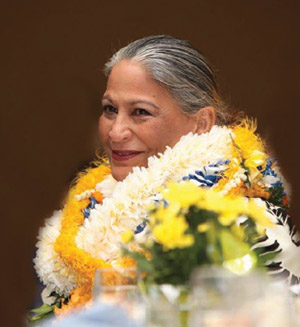
Now a grandmother of four, Skylark’s son Imakakoloa has a daughter, Kahena, and her daughter Kilohana, who lives in California, has three sons: Iolani, age five, Mana, age three, and Keanu, two months. Her son, Makana, is still at home with her.
Slowing down a bit, Skylark says she is enjoying being mentor to others. “There is such good talent. I just do weekends on KAPA radio, from 8 to noon Saturday and Sunday. We are getting a lot more talented people writing Hawaiian music for today that will take us into the future. With the music’s resurgence, they have groomed new writers. I’m just floored by these kids. There was a time I was worried it was going off track, and now it’s come full circle and I’m so happy. I feel Hawaiian music is going to be supported and go forward.”
After more than 30 years of hosting Merrie Monarch events, she bowed out this year. You can find her, however, at the Ka‘ū Coffee Festival on May 5. Also on her calendar is the Annual Gabby Pahinui Festival in Waimanalo, Hilo native Kuana Torres Kahele’s Hawai‘i Island concert tour, and the Seattle Slack Key Festival. ❖
Contact Skylark Rossetti.
Contact Aaron Miyasato.
Contact Hawai‘i Academy of Recording Arts.
Contact writer Karen Valentine.

